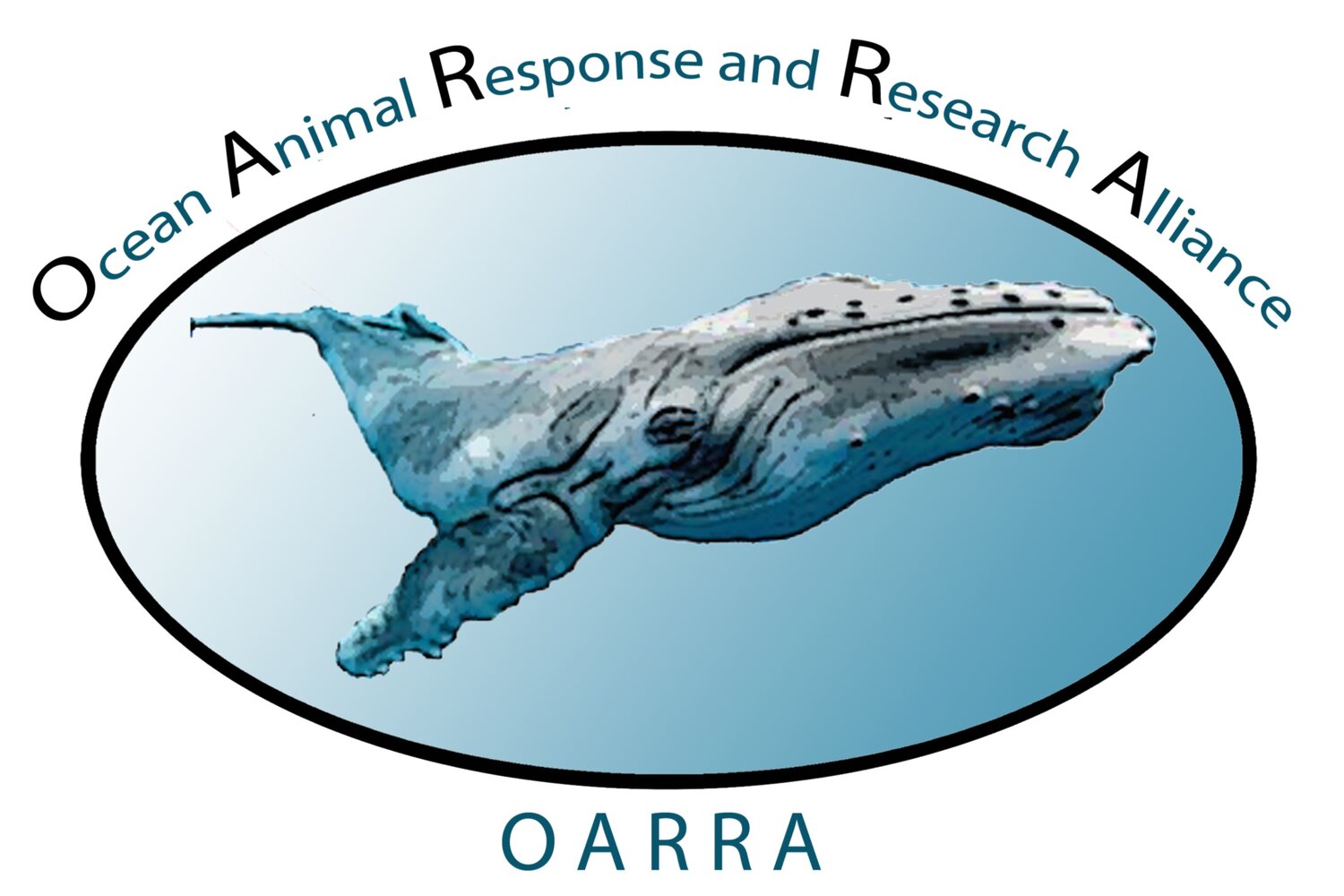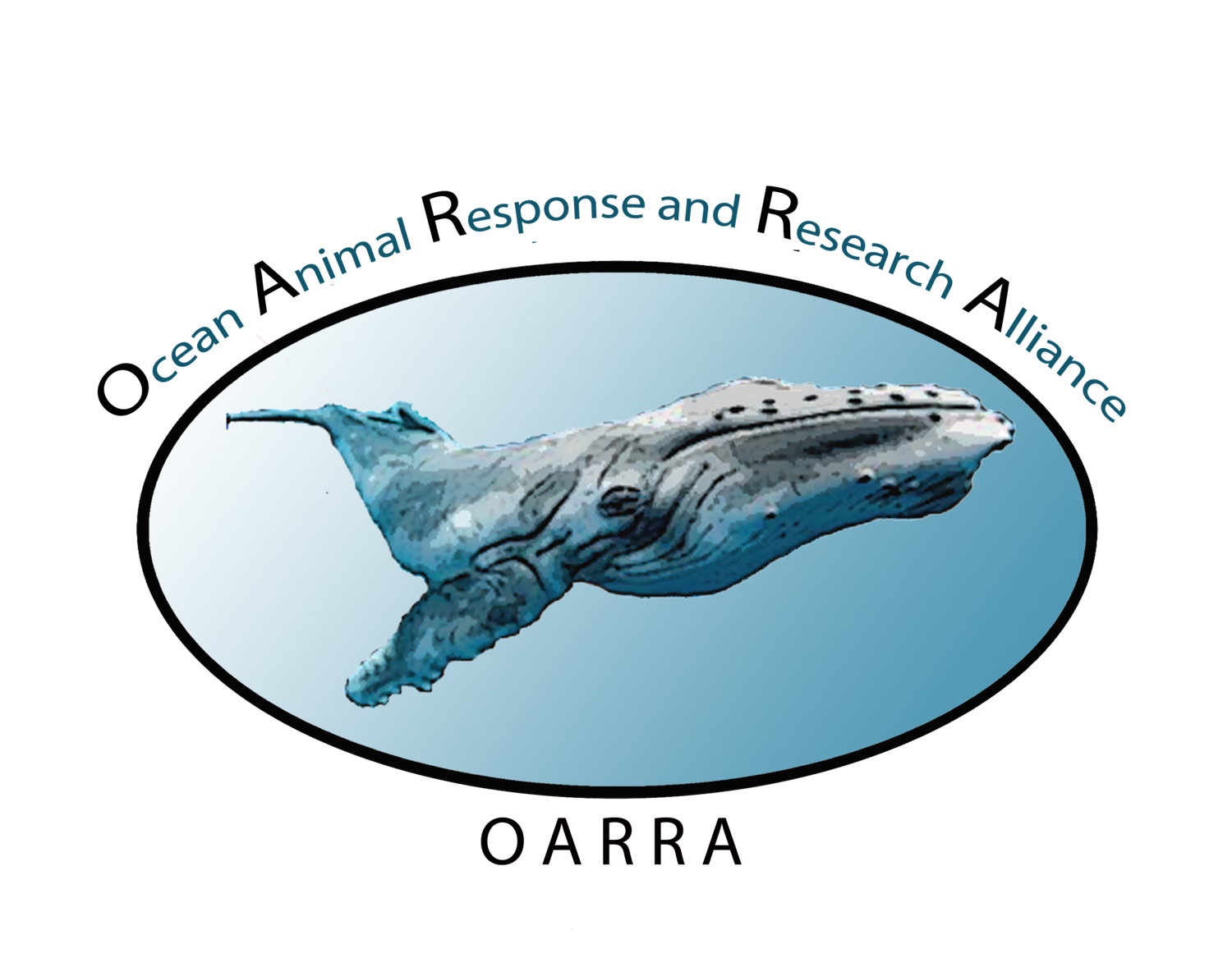|
OARRA's Summer Field Report: 2024
|
|
|
OARRA's Survey & Monitoring Program spots a large pod of common dolphins (Delphinus delphis) traveling and feeding in the Port of LA in the midst of industrial shipping infrastructure. Credit: OARRA
|
|
|
What did you do on your summer vacation? OARRA's crew had our fair share of beach days and boat days, though perhaps equipped more often with bone saws than beach towels. It's officially autumn, and OARRA is reflecting on a busy summer of growth, development, response, and research before descending into the harvest season.
Read on for updates from a sunny SoCal stranding summer. (Say that five times fast.)
|
|
Your support makes OARRA's conservation missions possible.
Our conservation and research work is kept afloat by the compassion, curiosity, and enthusiasm of dedicated volunteers, donors, collaborators, and citizen scientists.
Please consider contributing to OARRA this month to help give the marine animals of Southern California a voice through OARRA's research and response programs. 100% of your generous donation will directly benefit our:
Donating to OARRA's programs is now available through Aplos and Venmo.
Every donation makes an incredible difference. We are thankful down to the oceanic depths for your support! Donations are 100% tax-deductible.
|
|
Want to volunteer with OARRA?
OARRA's programs are always in need of all hands on deck... often literally.
Are you interested in hands-on marine science fieldwork in Los Angeles and Orange County? Do you want to gain experience in the stranding field or contribute to marine wildlife research, response, and education efforts? Volunteering with OARRA is an incredibly accessible and immersive way to participate in marine animal science at any level of experience. Apply at the link below or forward along to an ocean lover in your life.
|
|

|
|
OARRA's Survey & Monitoring Program spots an adult male California Sea Lion (Zalophus californianus) hauled out in the Port of Los Angeles. Adult males can be identified easily by their prominent "bump," or sagittal crest, at the top of their head. Credit: OARRA
|
|
Survey & Monitoring Program Recap:
OARRA enjoyed the warm weather and calm seas of summer while conducting weekly live animal population abundance surveys of the Los Angeles and Orange County coastline, Ports of Los Angeles and Long Beach, and offshore oil platforms in order to monitor population dynamics, site fidelity, animal health, flipper tag and bird band resightings, entanglement incidence, and more. So far in 2024, OARRA has embarked on 36 Survey and Monitoring trips. Our sightings in Los Angeles County and Orange County have included:
- 4,557 Pinnipeds
- 4,122 California Sea Lions
- 435 Harbor Seals
- 11,399 Cetaceans
- 11,129 Common Dolphins
- 232 Bottlenose Dolphins
- 20 Pacific White-Sided Dolphins
- 9 Gray Whale
- 7 Fin Whale
- 1 Blue Whale
- 1 Unidentified Cetacean
- 117 Flipper Tag Sightings Reported
- 19 Pelican Band Sightings Reported
- 28 Entanglements Reported
Explore sighting details, photos, and data maps online on OARRA's website.
|
|

|
|
California Sea Lion (Zalophus californianus) W7187 suns himself, dolloped on a dedicated marine mammal barge in Redondo Beach. Credit: OARRA
|
|
Have you spotted a flipper-tagged marine mammal? Citizen scientists like you can help OARRA and our alliances by reporting a tag sighting! These identifiers indicate animals that have been treated and released by rehabilitation facilities or marked for study by research teams. Monitoring tagged animals in the wild is critical to marine mammal science, management, and conservation.
|
|
Reporting bird leg band sightings is also a crucial way you can help researchers and responders monitor individual animals' continued health and movement long after they've left a rehabilitation facility.
|
|
|
As always, please remember to Share the Shore and keep your distance from wildlife. These animals need plenty of space and security to thrive, as human interaction and interference is energetically expensive and often ends up acutely harmful. In the field, OARRA utilizes telephoto lenses and binoculars to observe marine animals in detail from an appropriate distance, and many of our photos are tightly cropped. Please respect wildlife's rights to an undisturbed environment and enjoy their natural behaviors from afar. Check out NOAA's Marine Life Viewing Guidelines to ensure wildlife safety.
|
|

|
|
A dead stranded California Sea Lion (Zalophus californianus) is examined and prepared for brain sampling at OARRA's laboratory during a training necropsy workshop. Skin and muscle are first removed from the skull for direct bone access with a necropsy saw for a clean, controlled cut. Credit: OARRA
|
|
Mortality Response & Research Program Recap:
Not all of OARRA's sightings are live animals. In 2024 so far, OARRA has responded to 95 marine animal mortalities in Los Angeles County:
- 72 Pinnipeds
- 64 California Sea Lions
- 1 Harbor Seal
- 2 Northern Elephant Seals
- 2 Northern Fur Seals
- 2 Unidentified Pinnipeds
- 18 Cetaceans
- 7 Common Dolphins
- 5 Bottlenose Dolphins
- 1 Pacific White-Sided Dolphin
- 1 Northern Right Whale Dolphin
- 1 Risso's Dolphin
- 1 Gray Whale
- 2 Fin Whales
- 3 Sea Turtles
- 2 Green Sea Turtles
- 1 Loggerhead Sea Turtle
- 2 Other
- 1 Bat Ray
- 1 Southern Sea Otter
Explore case details, photos, and data maps online on OARRA's website.
|
|

|
|
A close shot of a California Sea Lion's (Zalophus californianus) trachea and surrounding tissues is taken during a necropsy before sampling. All organs and tissues are documented during an examination for analysis and reference. Credit: OARRA
|
|
|
These cases continue our work of biosurveillance for emerging and proliferating pathogens, documentation of baseline population data and anthropogenic threats, and the extension of immersive fieldwork opportunities to students and early-career researchers.
As always, we are grateful to work with these animals in life and death; caretaking the gift of their bodies and giving voice to their stories through comprehensive examination, sampling, and analysis is a critical part of understanding the health of their populations and the threats they face in our oceans.
Please report marine mammal and sea turtle mortalities in Los Angeles County to OARRA's Marine Animal Mortality Response Hotline: ☎️ (949)-276-2237. Your reports ensure that every animal's story gets told.
|
|

|
|
Los Angeles County Lifeguards look on as Department of Beaches & Harbors crews work to stabilize a dead stranded fin whale (Balaenoptera physalus) in Torrance. Credit: OARRA
|
|
OARRA's S.E.A. State:
We are proud of the many developments in our Service, Education, & Alliance work in summer 2024!
|
|

|
|
OARRA volunteer Kevin C. and members of the Orange Coast College Marine Mammal Research Group present a poster on coastal bottlenose dolphins. Credit: OARRA
|
|
OARRA volunteer and data wrangler Kevin C. led an undergraduate research team and produced a poster at Orange Coast College's annual Giles T. Brown Research Symposium, "A Geographical Survey of Local Southern California Coastal Bottlenose Dolphins (Tursiops truncatus)." OCC's Marine Mammal Research Group continues to explore exciting and engaging work on coastal bottlenose dolphin populations and dorsal fin recognition programs in Southern California. OARRA is proud to support their work by sharing our data and photos of Tursiops survey sightings with their team. Congratulations!
At the end of spring season, OARRA also performed a demonstration necropsy on a common dolphin calf (Delphinus delphis) for OCC marine science students. We have been excited to collaborate with OCC and other area colleges to support ongoing research on heavy metal and DDT concentrations in cetaceans with samples sourced from our mortality response program. We look forward to continued partnership with OCC's Marine Science department and forthcoming research results.
|
|

|
|
OARRA volunteer Erica A. trains in making incisions on a Northern fur seal (Callorhinus ursinus) at Southern California Marine Institute. Credit: OARRA
|
|
|
OARRA is excited to be a new Southern California Marine Institute tenant this year on Terminal Island. Many of our mortality cases are now processed at our laboratory, allowing flexible facilities for examination, training workshops and necropsies, and specimen processing. SCMI has also been home to OARRA's growing volunteer program onboarding as we have continued to hold new group orientation classes throughout the summer, including our new Mortality Response Program First Responder Orientation and Survey & Monitoring Program Orientation. We are grateful to consider SCMI our base camp and look forward to ongoing collaborations on and off campus.
|
|
|
OARRA was presented with a unique opportunity for logistical collaboration when we received a report of a dead stranded Southern Sea Otter in Los Angeles County. We are grateful to our contacts at California Department of Fish and Wildlife for facilitating this uncommon mortality case. Read on in our quarterly Sighting Spotlight below for more information about this animal's stranding and response.
|
|
|
We are also thankful to the Rotary Club of Laguna Beach for their generous contribution of a community grant supporting interactive STEM education for Laguna Beach high school students. We are thrilled to help students dive into marine science fieldwork by hosting them in the field, supporting them in developing and executing student-driven research questions about ocean animal ecology in Southern California, and mentoring their exploration of secondary education and career prospects in our field. We look forward to engaging our incoming generation of scientists and conservationists as we work to better understand and ensure the future of ocean animal health.
|
|

|
|
OARRA staff strategize with other West Coast Stranding Network collaborators on the case of a dead stranded fin whale in Torrance, CA. Credit: OARRA
|
|
And as always, we are also incredibly grateful to our NOAA West Coast Stranding Network partners and the Los Angeles County Department of Beaches & Harbors for their continued collaboration. Their support was particularly instrumental in the examinations of two stranded endangered fin whales this summer in the Port of Los Angeles and in Torrance, CA. As the designated West Coast Stranding Region organization for marine animal mortality response in Los Angeles County, we were thankful to work with so many other Southern California allies in facilitating the response to these large animals.
If you are interested in outreach, education, collaboration, and press opportunities with OARRA, please contact us at info@oarra.org. We can't wait to hear from you!
|
|

|
|
A Southern sea otter (Enhydra lutris nereis) is documented by OARRA staff during an intake exam. Credit: OARRA
|
|
Sighting Spotlight:
Indeed, as hinted in our S.E.A. State above, sometimes OARRA's Mortality Response Program is thrown a carcass curveball. When we receive a report of a deceased animal on the beach, occasionally the species is misidentified as another. When we received a report of a deceased "sea otter" in Playa del Rey, our dispatch team imagined this could have been a case of mistaken identity; a small common pinniped could easily be misidentified as a regional rarity. However, this identification was dead on.
That's why this Southern Sea Otter (Enhydra lutris nereis) is our Sighting Spotlight of the Month!
This animal's case is a testament to the efficient collaborative relationships built in our organizational networks. As OARRA's mortality response program does not cover mustelids, we worked quickly with LAC Beaches & Harbors to recover the carcass, document it, and transfer it to our collaborators at the California Department of Fish and Wildlife in order to place the carcass with sea otter specialists for a complete examination and necropsy.
Examination revealed that this animal was a young immature female otter, estimated by CDFW at 15 weeks old. Sea otters are rare modern sightings in Los Angeles County; this case is suspected to be an errant otter from the slowly-increasing San Nicholas Island translocation population established in the 1980s, not indicative of a LAC mainland stock.
Otters remain with their mothers as dependents for about six months on average until they are strong and developed enough to survive on their own. At only fifteen weeks, this otter would have been quite shy of that developmental benchmark, and may have become prematurely separated from her mother and drawn to the mainland where she was ultimately found emaciated and deceased.
Former otter abundance on the West Coast was decimated by the fur trade; the Marine Mammal Commission estimates that Southern sea otter stock once ranged between 150,000-300,000 individuals. For reference, this upper estimate is the present-day population estimate of the California sea lion — not at all an uncommon sighting on our coastline. Though sea otter populations have rebounded from a dwindling population of 50 in the 1930s to around 3,000 in recent years, sightings in Los Angeles — live or dead — are still markedly uncommon.
If you encounter a marine animal mortality floating or stranded, please don't hesitate to reach out to the correct authorities in your jurisdiction. Details that help response teams include: well-lit photos and/or videos of the carcass taken from a safe distance (especially with scale in the photo and landmarks in the background, and especially with identifying features like the head, teeth, or extremities visible), GPS coordinates from your phone, a description of the animal's location (e.g. "in front of Lifeguard Tower 40 on Dockweiler Beach at the water's edge"), and time of sighting (for gauging tidal changes during response). A comprehensive report of this otter's stranding, complete with photos and GPS coordinates, helped OARRA make a swift evaluation and recovery of this valuable specimen. We appreciate all involved.
|
|
|
Thank you for your support!
"Sea" you soon!
|
|
|
|
|



















